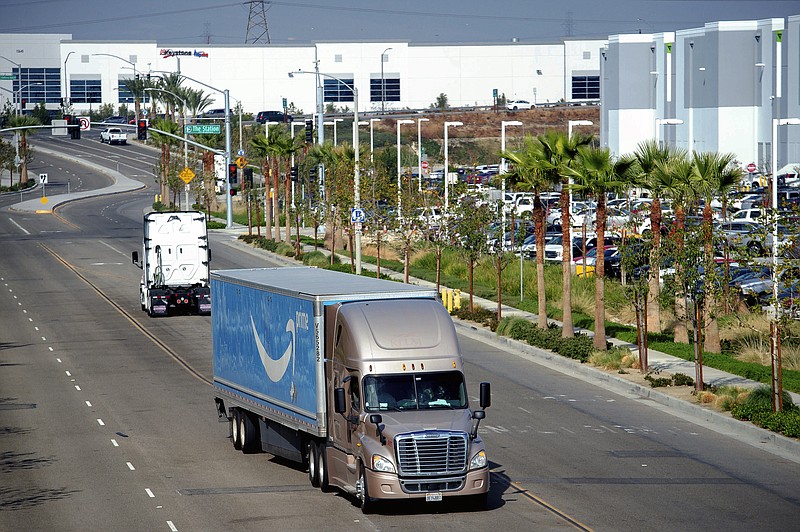LOS ANGELES -- Southern California air quality regulators Friday approved a rule that would curb diesel emissions from thousands of trucks that ferry goods from the growing number of massive warehouses in the region run by Amazon and other companies.
Areas around the facilities have weathered increased pollution affecting their largely minority communities.
The so-called warehouse rule was approved 9-4 by the South Coast Air Quality Management District board.
It institutes a points-based system requiring about 3,000 distribution centers to choose from a menu of options to reduce or offset emissions. Those could include choices such as replacing diesel trucks and other equipment with electric models, putting in rooftop solar panels or installing air filters at nearby schools or day care centers.
"Warehouse operators could prepare and implement a custom plan specific to their site, or they could pay a mitigation fee," the proposal read. The fees would go toward funding similar air quality improvements in surrounding neighborhoods.
Known as an "indirect source rule," the effort is unusual because it largely targets emissions from the trucks that service warehouses rather than the warehouses themselves. In the past, similar approaches have been made to address the heavy traffic drawn by stadiums or shopping malls.
South Coast district officials said they acted in order to meet federal smog-reduction deadlines in 2023 and 2031.
According to estimates by the regulator, its plan will reduce nitrogen oxide emissions by up to 15% and result in up to 300 fewer deaths, up to 5,800 fewer asthma attacks and up to 20,000 fewer lost work days between 2022 and 2031. The district estimated that public health benefits could be as much as $2.7 billion, about three times the projected costs.
The emissions are a major contributor to smog-causing nitrogen oxides and diesel particulate matter pollution, which are linked to health problems including respiratory conditions.
The pollution has taken a particularly heavy toll in Southern California, which suffers from the nation's worst air quality. The heavy presence of industry in the region, combined with heat waves and wildfire smoke, helped make 2020 the smoggiest year in the region since the mid-1990s. Minority neighborhoods have been disproportionately affected.
Environmental and activist groups praised the vote, saying it will reduce pollution while providing local clean-energy jobs.
The rule "is the first step in eliminating toxic emissions from one of the nation's largest and most profitable industries," said a statement from the Sierra Club, Earthjustice, the People's Collective for Environmental Justice and the Partnership for Working Families.
"Squinting through the smog, California is charting a better future for the sake of our lungs, " said Adrian Martinez of Earthjustice. "The health benefits will be immense, but the indirect source rule is just the beginning. The way we move goods in this country has got to be electric, for the sake of clean air and a breathable future."
QUANDARY FOR BUSINESS
But the Los Angeles County Business Federation said the rule amounts to an unauthorized job-killing tax and called the Air Quality Management District's action "irresponsible" and "a travesty."
"The staff advised the board that this rule and tax will eliminate tens of thousands of jobs, with no evidence it will actually reduce emissions," the business group said. "What's more, these job losses will disproportionately impact communities of color, the same communities the board is claiming to support. This is not how public policy should be made."
B.J. Patterson, chief executive of Pacific Mountain Logistics, which employs more than 65 people at a 200,000-square-foot warehouse in San Bernardino, told the Los Angeles Times that he didn't know which of the compliance options his company would select.
Most of the forklifts used inside are already electric, he said, and he does not control which trucks come in and out.
Opting to pay the mitigation fees would cost his business close to $200,000 a year, he estimated.
SURGE IN WAREHOUSES
Environmental and community groups have for years pushed for tighter regulations to help neighborhoods inundated with smog-forming nitrogen oxides from trucks driving to and from sprawling warehouse complexes owned by Amazon and other distributors across the inland region east of Los Angeles.
The region, which includes portions of Los Angeles, Riverside and San Bernardino counties and all of Orange County, has a population of 18 million people -- more than most states.
More than 2.4 million people in the region live within half a mile of at least one large warehouse, and those areas have higher rates of asthma and heart attacks, and are disproportionately Black and Hispanic, district officials said.
And the industry is surging. Last year, the area close to the Los Angeles-Long Beach port where retailers and manufacturers offload billions of dollars in goods, added 23 million square feet of warehouse construction, an area the equivalent of nearly 500 football fields.
Information for this article was contributed by Christopher Weber of The Associated Press and by Hiroko Tabuchi of The New York Times.

